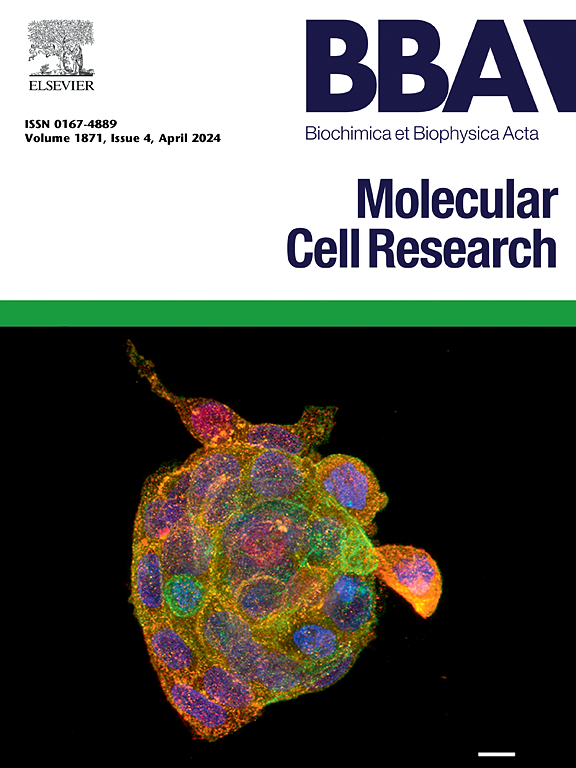SIRT3 impairment and MnSOD hyperacetylation in trophoblast dysfunction and preeclampsia
IF 3.7
2区 生物学
Q1 BIOCHEMISTRY & MOLECULAR BIOLOGY
Biochimica et biophysica acta. Molecular cell research
Pub Date : 2025-02-10
DOI:10.1016/j.bbamcr.2025.119915
引用次数: 0
Abstract
Preeclampsia (PE) is a prevalent obstetric disorder that affects 2–8 % of pregnancies worldwide. Trophoblasts, which are crucial functional cells in the placenta, play a significant role in the development of PE due to inadequate invasion. Sirtuin 3 (SIRT3) is an NAD+ − dependent mitochondrial deacetylase, that positively modulates energy metabolism, mitochondrial biogenesis, and protection against oxidative stress. However, the role of SIRT3 in trophoblast dysfunction and the pathogenesis of PE remains unclear. In this study, we aim to investigate the functional role of SIRT3 in PE and explore the underlying mechanism. Our results demonstrated that human PE placentas exhibited reduced expression of SIRT3. In vitro experiments showed that hypoxia promoted SIRT3 expression, while oxidative stress inhibited SIRT3 expression in HTR-8/SVneo cells. The reduced SIRT3 expression inhibited the proliferation and migration of trophoblast cells while also increasing levels of reactive oxygen species and inflammatory factors. As a deacetylase, SIRT3 deficiency increased the acetylation level of manganese superoxide dismutase (MnSOD), a key mitochondrial antioxidant enzyme, subsequently reducing its activity. These effects associated with reduced SIRT3 expression could be reversed by treatment with MnSOD mimetics TEMPO and overexpression of MnSOD. All these results suggested that diminished SIRT3 expression leaded to MnSOD hyperacetylation and inactivation, contributing to trophoblast dysfunction and the pathogenesis of PE.

滋养细胞功能障碍和子痫前期的SIRT3损伤和MnSOD超乙酰化
子痫前期(PE)是一种普遍的产科疾病,影响全世界2 - 8%的妊娠。滋养细胞是胎盘中至关重要的功能细胞,由于浸润不足,在PE的发展中起着重要作用。Sirtuin 3 (SIRT3)是一种依赖NAD+的线粒体去乙酰化酶,积极调节能量代谢、线粒体生物发生和抗氧化应激。然而,SIRT3在滋养细胞功能障碍和PE发病机制中的作用尚不清楚。在本研究中,我们旨在研究SIRT3在PE中的功能作用并探讨其潜在机制。我们的研究结果表明,人类PE胎盘显示SIRT3的表达降低。体外实验表明,缺氧促进SIRT3表达,氧化应激抑制HTR-8/SVneo细胞SIRT3表达。SIRT3表达的降低抑制了滋养细胞的增殖和迁移,同时也增加了活性氧和炎症因子的水平。作为一种去乙酰化酶,SIRT3缺乏增加了线粒体抗氧化酶锰超氧化物歧化酶(MnSOD)的乙酰化水平,从而降低了其活性。这些与SIRT3表达降低相关的效应可以通过MnSOD模拟物TEMPO和MnSOD过表达来逆转。以上结果提示SIRT3表达降低导致MnSOD超乙酰化失活,参与滋养细胞功能障碍和PE发病机制。
本文章由计算机程序翻译,如有差异,请以英文原文为准。
求助全文
约1分钟内获得全文
求助全文
来源期刊
CiteScore
10.00
自引率
2.00%
发文量
151
审稿时长
44 days
期刊介绍:
BBA Molecular Cell Research focuses on understanding the mechanisms of cellular processes at the molecular level. These include aspects of cellular signaling, signal transduction, cell cycle, apoptosis, intracellular trafficking, secretory and endocytic pathways, biogenesis of cell organelles, cytoskeletal structures, cellular interactions, cell/tissue differentiation and cellular enzymology. Also included are studies at the interface between Cell Biology and Biophysics which apply for example novel imaging methods for characterizing cellular processes.

 求助内容:
求助内容: 应助结果提醒方式:
应助结果提醒方式:


